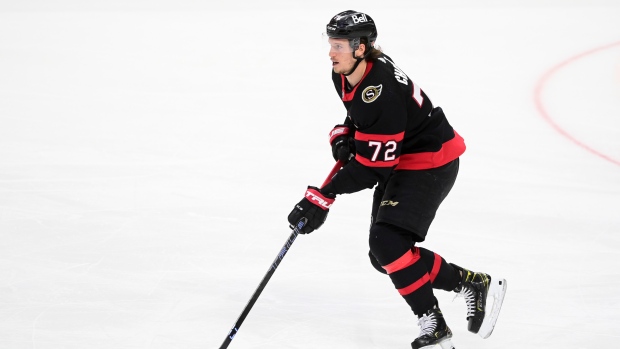Jan 27, 2022
Chabot shines, but the Sens still have work to do
The glass-half-full approach to this Ottawa Senators team is that their star players, starting with Thomas Chabot, are starting to see real results. It's with the glass-half-empty approach where glaring problems are still very visible. Travis Yost has more.
By Travis Yost

When a team is 13-20-3, you have to squint to find the positives. That’s the case for the Ottawa Senators right now, who find themselves in the familiar position of looking up at the rest of the Eastern Conference, save for the Montreal Canadiens.
But there is reason to be optimistic about elements of this Senators roster. Surely the influx of young talent (talent that’s still arriving, mind you) is great. But at some point, you need that young talent to show progress. You need to start winning games. You need to develop confidence that the players who make up your core can deliver wins.
At some point, having been a great player at the junior level and merely being considered young by NHL standards isn’t indicative of progress.
Which brings us to 24-year-old blueliner Thomas Chabot, Ottawa’s first defensive pairing, and where there is an interesting divergence in performance.
Chabot is well-regarded at this point in his career, and along with Brady Tkachuk, is the face of the franchise. The team has invested heavily in Chabot, betting he would anchor the defence (and deliver wins) for many years.
Through the ugliest parts of the rebuild, the Chabot pairing – like the rest of the Senators lineup – was usually shellacked. You can’t hide from poor goaltending, poor shooting talent up front, and mistake-prone defensive players. That trend has meaningfully reversed this season.
I want to emphasize Ottawa’s performance with and without Chabot, because I think this is a hallmark indicator for how well a defensive player (or pairing) is performing and helps us better understand game flow from the impact of the defensive side of the ice. Elite defensive players show themselves in one of two ways: incredible differentials driven through territorial dominance, or high-end defensive play that stymies opposing offences.
Consider Ottawa’s rolling goal differentials throughout this rebuild through the lens of whether the Chabot pairing was on the ice. For years, the Chabot group struggled to break-even, whereas depth players were routinely underwater.
This season, while playing on the hip of Artem Zub and with a healthy rotation of Tkachuk, Drake Batherson, and Tim Stutzle minutes, Chabot has changed the narrative:

For the first time in his playing career, the Senators are meaningfully better than their opponents with Chabot on the ice, having outscored their opponents 44-to-34 (+10). If you are GM Pierre Dorion and the Ottawa front office, this data point should excite you. The Senators are finally starting to see advantage play when the team’s big guns are on the ice.
What has notably changed this season is Ottawa’s ability to hold the offensive zone with their skill players and convert on some of those chances. What you end up seeing is a relatively dangerous Ottawa team when the Chabot pairing is on the ice, again usually with the team’s top-six forwards.
When he’s not playing, the Senators can’t generate any meaningful offence (via HockeyViz):

And therein lies the concerns with the divergence in this roster. The glass-half-full approach to this Senators team is that their star players, starting with Chabot, are starting to see real results. When they are clicking, this team is competitive. But the glass-half-empty approach is desperately concerned with the rest of the lineup – in particular, all those minutes without the Chabot pairing on the ice.
When Ottawa’s depth forwards and depth defensive players are deployed, the team is not competitive. They can’t generate anything offensively and leave themselves vulnerable to getting bottled up in the defensive end for full shifts. In just 36 games this year, the Senators have been outscored 53 to 30 (-23) with Chabot on the bench.
If that ever positively reverses, we may start seeing this Ottawa team in a different light, one that could compete with mid-tier Eastern Conference teams.
But it’s imperative the rest of the roster is built out; we have seen what an inability to do so can do to a franchise, even one with two superstar players.

